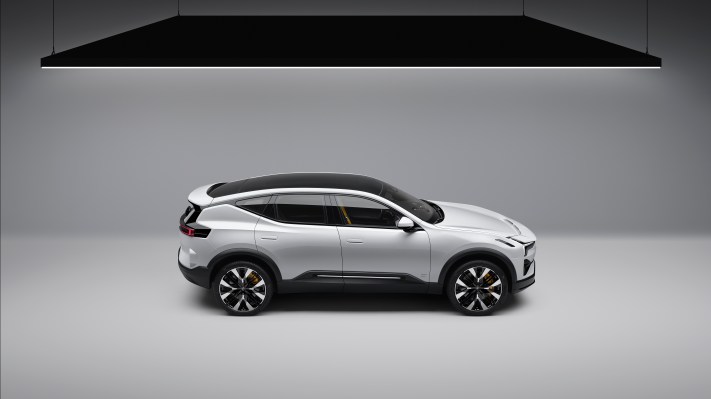Polestar, the EV subbrand from Volvo and Geely that launched last week on the Nasdaq at a $20 billion valuation, didn’t earn its $PSNY ticker by taking the traditional route toward an IPO.
With the ringing of the bell, Polestar became the latest EV maker to hurry to the stock exchange by merging with a special purpose acquisition company, or SPAC, before becoming profitable.
Being under Volvo’s aegis gives Polestar a head start over typical electric vehicle startups, though its production targets could prove challenging given their relative scale when compared to other recently SPAC’d EV companies.
The merger with blank-check company Gores Guggenheim raised roughly $890 million for Polestar, which will use the money to fund an aggressive three-year growth plan. But so far, despite its considerable resources as the child of a multinational conglomerate, its stock has largely stagnated. It debuted at $10 per share and jumped to $13 after the SPAC merger was completed on June 24, but was trading Wednesday morning around $9.70 per share.
Last year, when Polestar announced plans to go public by merging with a SPAC, the climate was different. Soaring enthusiasm around EVs, and startups with pie-in-the-sky plans to build EVs, stoked investor appetite and compelled many early-stage companies to cash in through blank-check companies.
So far this year, however, performance has been spotty, vulnerable to the volatility and tumbling valuations that ultimately cooled the red-hot market for SPACs and soured investors on the financial tool. The 70 deals completed during the first six months of 2022 are well behind the pace of the 613 deals made in 2021, according to figures from SPAC Research.
In June alone, Electric Last Mile Solutions filed for bankruptcy, the U.S. Department of Justice began an investigation into Faraday Future, and the U.S. Securities and Exchange Commission concluded a comment period on proposed regulations that would put SPACs under more scrutiny.
Where Polestar can win
Polestar’s connections to Volvo and Geely set it apart from the other EV SPACs, like Lordstown Motors and Canoo, that struggled with raising the funding to open their factories (during the same week in May, Lordstown sold its Ohio plant to Foxconn and Canoo issued its own financial warning.) Polestar’s main advantage is the ability to contract manufacturing out to its two largest shareholders, Geely and Volvo, at Geely’s Zhejiang factory for the Polestar 2 and at Volvo’s Charleston factory for the release of the Polestar 3.
“Polestar can focus on tinkering with the vehicle’s performance and design, while letting the established OEMs manufacture the vehicles,” said Jack Shea, CFO at Snow Bull Capital, a green- and high-tech hedge fund.
Anointed in 2017 as Volvo’s standalone EV brand, Polestar has progressed beyond startup status to self-styled Tesla challenger due to the resources of its parent company. Volvo Cars now holds a 48% stake in the company (valued at around $10 billion).
And unlike many of the other EV SPACs, it already generates revenue and has a nameplate for sale in key markets including the U.S., China and Europe. The automaker said it has received more than 32,000 orders for its Polestar 2 — a follow-up to its discontinued, 600-horsepower Polestar 1 plug-in hybrid — from customers in 25 markets.
The automaker also has an enviable network, including a $3 billion agreement to sell 65,000 EVs to Hertz over the next five years. The scale of the deal is likely to expose a wide swath of consumers to the Polestar brand.
Overall, the company plans to grow its presence to 30 countries by the end of 2023 and sell 290,000 cars annually by 2025 — about 10 times Polestar’s 2021 sales.
“We will now open a new chapter in our story that can be summarized in one word — growth,” Polestar CEO Thomas Ingenlath said in a statement. “We already have a real and successful business; this listing gives us the funds and platform to help deliver our ambitious future plans and drive industry-leading sustainability goals forward.”
The infrastructure already in place makes Polestar less likely to fall prey to the dangers facing some of the other SPACs that build EVs, such as being delisted from Nasdaq for not filing documents on time or being investigated by the SEC or DOJ for misleading investors with unrealistic projections.
Where it may struggle
Certainly, Polestar is not immune to financial pressures. Even as it debuted on the Nasdaq, Ingenlath said that the company is unlikely to generate profits until closer to 2025 and warned of a need to raise more money before that.
The brand has already run into manufacturing problems, according to the JD Power Initial Quality Study (IQS) released last week that ranked Polestar last. Polestar owners reported about 328 problems per 100 vehicles, 24% more than Chrysler, the report’s second-lowest ranking brand with 265 problems per 100 vehicles.
“When you operate at the high end of the market against competition like Porsche and others, those kinds of quality challenges are not acceptable or sustainable,” said Stephen Beck, managing partner of management consultancy cg42. So far, it hasn’t “done enough to establish the brand halo required to continually operate successfully at the high end at a greater scale.”
The three-year growth plan calls for the start of production on its first SUV, the Polestar 3, followed by the Polestar 4 midsize crossover and Polestar 5 flagship sedan. But creating a credible EV company is the first challenge; scaling it to size is the gauntlet.
“Polestar is likely a brand that will end up ‘stuck in the middle’ — not good enough for the high-end market and not affordable enough to operate at scale,” Beck said. “That is a tough position to defend.”
